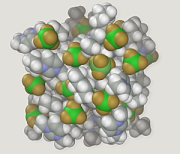
Molecular modelling encompasses all methods, theoretical and computational, used to model or mimic the behaviour of molecules.[1] The methods are used in the fields of computational chemistry, drug design, computational biology and materials science to study molecular systems ranging from small chemical systems to large biological molecules and material assemblies. The simplest calculations can be performed by hand, but inevitably computers are required to perform molecular modelling of any reasonably sized system. The common feature of molecular modelling methods is the atomistic level description of the molecular systems. This may include treating atoms as the smallest individual unit (a molecular mechanics approach), or explicitly modelling protons and neutrons with its quarks, anti-quarks and gluons and electrons with its photons (a quantum chemistry approach).
- ^ Leach AR (2009). Molecular modelling : principles and applications. Pearson Prentice Hall. ISBN 978-0-582-38210-7. OCLC 635267533.